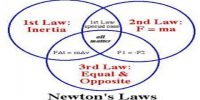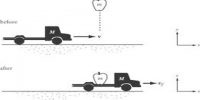First law: Object remains in a state of rest or in a state with constant velocity, unless compelled to change by a net force. The first Newton’s law defines inertial reference frames.
Second law: The acceleration of an object with mass (m) is proportional to the net force acting on it:
∑ F = ma
Third law: whenever the first body exerts force on the second body, the second body exerts force on the first body that is equal in magnitude and opposite in direction. In short, forces always appear in pairs. The unit for force follows: [F] = [m] * [a] = kg m/s2 = N, or Newton.
The net force is the sum of physical forces acting on an object. In introductory physics, the list of physical forces is quite small: weight mg, the tension T in a rope, the contact force, or normal force FN, and friction force fk. When an object sits on a block [so that the acceleration is zero], the net force on the block is zero. The weight of the block is directed downwards with magnitude W = mg. This force is balanced by the normal force the table exerts on the block; we have for the magnitude FN = mg and the direction is upwards. “Normal” refers to the mathematical meaning of “perpendicular?’ In general, the normal force is always directed perpendicular to the surface.
The friction force is directed against the direction of motion, and the magnitude is proportional to the normal force,
fk = μk FN














